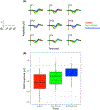Assessing Trial-to-Trial Variability in Auditory ERPs in Autism and Schizophrenia
- PMID: 36207652
- PMCID: PMC10079782
- DOI: 10.1007/s10803-022-05771-0
Assessing Trial-to-Trial Variability in Auditory ERPs in Autism and Schizophrenia
Abstract
Sensory abnormalities are characteristic of autism and schizophrenia. In autism, greater trial-to-trial variability (TTV) in sensory neural responses suggest that the system is more unstable. However, these findings have only been identified in the amplitude and not in the timing of neural responses, and have not been fully explored in schizophrenia. TTV in event-related potential amplitudes and inter-trial coherence (ITC) were assessed in the auditory mismatch negativity (MMN) in autism, schizophrenia, and controls. MMN was largest in autism and smallest in schizophrenia, and TTV was greater in autism and schizophrenia compared to controls. There were no differences in ITC. Greater TTV appears to be characteristic of both autism and schizophrenia, implicating several neural mechanisms that could underlie sensory instability.
Keywords: Auditory; Autism; Event-related potentials; Inter-trial coherence; Schizophrenia; Trial-to-trial variability.
© 2022. The Author(s), under exclusive licence to Springer Science+Business Media, LLC, part of Springer Nature.
Conflict of interest statement
The authors have no conflicts of interest to declare.
Figures







References
-
- American Psychiatric Association DS, & Association AP (2013). Diagnostic and statistical manual of mental disorders: DSM-5 (Vol. 5). American psychiatric association; Washington, DC.
-
- Attneave F (1954). Some informational aspects of visual perception. Psychological review, 61(3), 183–193. http://europepmc.org/abstract/MED/13167245 - PubMed
MeSH terms
Grants and funding
LinkOut - more resources
Full Text Sources
Medical

